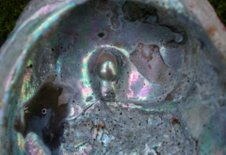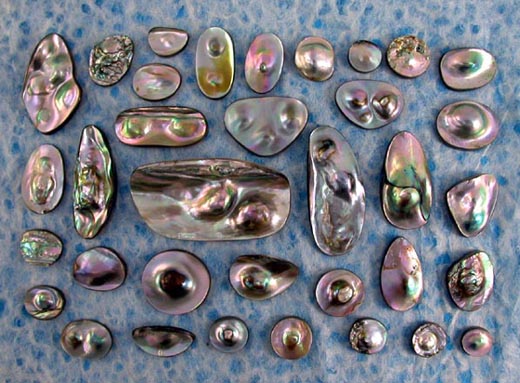at Ano Nuevo
Story from John Vonderlin
Email John ([email protected])
Hi June,
This article appeared shortly before the Fog Signal article about Ano Nuevo. It has stuff about the seals of Ano Nuevo I’ve never seen published or even hinted at. The passages about the lightkeeper killing the bulls that were killing the pups is poignant and quite mysterious. Enjoy. John
The seals of Ano Nuevo Island are prac –
tically unknown to both scientists and the
public, notwithstanding the fact that the
herds there are the largest on the Pacific
Coast and the habits ot” the species are
the most distinctive.
In many ways their habits are •omewhat
similar to those of sea birds. Once a year
the rock-, or rookeries, are covered witn
seals. Young are born and raised there,
and then a general migration takes place
of all hut the old females. For mcn’hs
the rookeries are comparatively deserted.
The seals come and go at regular intervals.
If you will look at a man of California,
and closely examine the southwestern
portion of the coast of Bkn Maieo County,
you will find Ano Nuevo Island. Although
only about thirty-five miles from San
Francisco, in a direct line, it is a most
difficult place to get at. If every Using
goes well it can be reached in about twelve
hours, but should there be a detention of
any kind the journey may consume two
days. The nearest town is Pescadeio,
fourteen miles to the north.
Ano Nuevo Island is cut off from the
mainland by a channel about a nule wide,
and the only way to cross is in the boat of
the keepers of the Government foe signal.
The seal rocks are scattered to the north –
ward of the island, the closest beinj: only
about 500 feet away.
It was for the purpose of ascertaining
something about the habits of these seals
and obtaining pictures of them that a
Call representative visited Ano Nuevo
Island last week, just in the height of the
breeding season. Keeper Bntweil of the
fog signal, whose opportunities for study –
ing seals have undoubtedly been most
favorable, gladly Jurnished all informa –
tion and acted as guide to the seal ro ks.
Rome -of the facts that be has gathered in
regard to the habits of seals and the
causes of their extermination are surpris –
ing and valuable. He has watched the
herds con-tantly at all seasons for a
per.od of eight years, and the location or
the rocks, lying as they do so close to the
island, makes the seals’ actions as easily
observable as if they were on the stage of
a theater.
“Years ago,” said Mr. Butwell, “there
used to be tens of thousands of seals on
these rocks, and the killing of them was a
profitable industry. The hides were used
lor belting and sold for a good price.
”In ihoie days the rocks were leased to
hunters, and the killing went on at a
rapid rate. Of course the seals rapidly
diminished in numbers, as males, lemaies
aiid pups were killed indiscriminately.
When I came bere eight years ago all this
had stopped. No hunters were allowed on
the rocks, and it would seem as if the
herds should have again multiplied; but
they didn’t. For (our years they kept ret –
ting fewer, until there were hardly 500
left.
“About this time I began to study the
cause of the decrease. From this point
here on the island I can lock across to the
rocks, and by taking a glass can bring
the seals up very close. I had previously
noticed that some of the bulis had a habit
of killing the young, but had no idea the
evil was so general as I found it to be on
investigation. One morning I saw a cer –
tain bull climb on the rocks and kill
about half a dozen pups. Others did the
same, so it was soon apparent to me that
the bulls were largely responsible for the
decrease of the herds.
“After becoming convinced that a num –
ber of vicious bull* did all the mischief I
began a systematic killing of them. 1
used to go over on the rocks and lie in
wait. Whenever I caught an old fellow
in the act of killing a pup I put a bullet
through his head. The lirst season I
killed about fifty and saved many hun –
dred pups, so that the second year the
herds began to increase and this year are
larger than they have been since I com –
menced my extermination of the vicious
bulls.
“The habits of these seals are most
peculiar an l mysterious. After the pups
are born on the rocks the cows spend two
or three months teaching them to swim,
and then when the time comes take them
to sea somewhere and leave them. The
young seals do not return to the place of
tljeir birth until they are two years old,
but where they spend the interval is a
mystery. So you see it took two years to
tell whether the killine of the vicious
THE SEAL ROOKERIES OFF THE COAST
OF SAN MATEO COVNTY.
bulls did any good or not. But lam sat –
isfied that it did. At any rate tne seals
are increasing at a fair rate, and in a lew
years, with proper nursing, I think they
will be as numerous as ever.
“But really when we look at it in the
right way there is no reason why the seals
should be preserved. 11 is purely a mat –
ter of sentiment. One fall-grown seal wll
destroy enough fish in a week to feed a
pood-sized town for a month, and the
damage done by the herd ‘a beyond con –
ception. Seals are really the coyotes of
the sea, and if we look after our own in –
teresta we w ou!d be making efforts to de –
stroy them instead of preserving them.
However, it is not likely they will be de –
stroyed, as they have ceased to be worth
anything coramerc ally.
“Tiie largest bull on tfee rocks would not
yield enough hide, whiskers, etc., to sell
for $1 50. When seal hides were used tor
belting they were worth about .s.”> each,
but since rubber I.aa been used for this
purpose they are no longer wanted. Seal
hide is only used nbw for making buffing
wheels, and of course the demand is very
light. Really the seals are not worth kill –
ing should one be so inclined, and any at –
tempt to do so as a matter of business
would surely result in loss.”
Every statement made by Mr. Butwell
was borne out by observation. Standing
on the northern edge of Ano Nuevo
Inland the seals’ methods of destroying
fish could be readily seen. The tide
sweeps rather swiftly through the chan –
nel between the two points, and naturally
a school of lisli would be carried alone
wilh it. The rookeries will be thickly
covered w”h s<als, but the instant a cer –
tain foamy streak appeared on the surface
of the water there will be an almost in –
stantaneous plunge into the sea. Then
the slaughter commences.
The surface of the water is churned into
foam and the frightened fish dart in ail
(Mrections only to run into more seals.
The amphibians bump into one another,
roar and r lunge after their jr^y. All is
tumult, commotion and death to ihe fi-h.
For a few minutes the seals undoubtedly
sa ivfy th’ir appetites by eating all the
fish they catch, but after that they simply
kill for fun. When a seal is hungry he
will swallow a iish whole and be chasinc
another while his victim is still in h;s
throat. Bnt when his hunger grows less
w Jj & IsSßilr ii-
SAN FRANCISCO, SUNDAY MORNING, JUNE 27, 1897.
ravenous he simply bites out the back and
throws the rest away. When he has had
all he wants the sea! playfully rolls over
the surface of the waves, catches a rish
and gives it a crunch. Of course deatn is
instantaneous and the body of the tish is
allowed to drop into the >ea. Providing
the air bladders of the fish have not been
broken the body will rloat, and often the
surface of the water will be literally cov –
ered with lar^e saimon, sea bass and
trout—enough to feed a town. Ot course
many more fish sink from sight, so that
the destruction is Mm ply appalling.
The fact that the bulls kill the youne
seals would appear to be simply another
demoQ;-tration of a certain admitted fact
of natural history. How such things
come about is of course a mystery, but
there are numerous instances ot the same
kind. It would seem as if nature bad con –
cluded that it was tune for a certain
species to become extinct and took this
means of accomplishing her end. That
s>be would always succeed goes without
saving—except where civilization ateps in
and puts a slop to it.
The most common demonstration of
this is the case of the ordinary barnyard
fowl. It is a weli-k’nown fact that where
tuere are as many cocks as hens chicks
cannot be raised. The cocks kill them,
and if they were unmolested the species
would soon become extinct. But civiliza –
tion steps in and destroys certain of the
cocks. Ad a consequence we have all the
chit-Kens we want.
Regardless of the destructive propensi –
ties of the s-eat and a number of bis objec –
tionable traits, he is the most picturesque
creature that lives in tie sea, and, it
might be added, the most picturesque that
lives on land. Like every other living
creature, the seal has good traits as well
as bad traits, and is most interesting to
watch. While it is a most difficult matter
to reach the seal jookeries the experience
is well worth the trip. It is replete with
incident, although not what would be
called dangerous.
At low tide it is possible to walk from
Ano Nuevo Island to the seal rocks. But
not “with a dry loot,” as the sailord are
wont to say.
Just at present the rookeries are in their
glory. The pups have all been born and
some of them are over a month old. At
the time of The Call representative’s
visit to the rocks Mr. Butwell had just
mads up his mind to dispose of a few
vicious bulls he bad seen killing ‘the
young, and h« led the way from the island
to the rookeries.
Climbing down the northern diff of the
island the way lay over moss- cove red
rocks laid bare by the low tide. Walking
is difficult work, as the ruo3s, beautiful as
it looks, affords a poor foothold. In fact
it affords no foothold at all, and it is only
by the greatest care that slipping is pre –
vented. Between the rocks arc pools of
clear water, several inches de<?D, that
must be waded through and care exercised
to prevent being tangled in the lone, | air, and falling on the rocks were crushed
slimy tendrils of seaweed. to death. Others were thrown into the
Just before the seal rock is reached sea and drowned, wl>lie a few were thrown
there is a channel about two feet deep and with only enough force 10 braak their rib-,
twenty feet wide that must be waded, so they would wallow around helplessly
The seals show little signs of fear. A to eventually die in agony,
few have plunged from the cliff, but the At mis stage of the game Mr. Butwell
others look at the intruders with curiosity raised his ride and put a bullet behind the
a few moments and then seem to forget. brute’s ear. With a thud, it leli to the
Seen from across the narrow channel, rock, but although a 45-caliber bullet with
the h«>rd of seals lining the edge of the ninety prams of powder behind it had
cliffs w;is a* grand n xißht ns the world been tired inlo its head, the bull was not
affords. There wer6 thousands and thou- dead. It quivered and flopped, and then
sands of the enormous creatures, closely a number of cows rushed up and attacked
packed in together like a flock ot birds, it fiercely. These were chased off with
In fact, the general effect of the herd was stones.
that of penguins. All the seals roar vio –
lently, ?o that it is impossible to bear the
human voice. What monsters they are,
and what power they possess of which
they arc unconscious.
Just before wading the channel Mr.
Butwell discharged his rifle. It was the
rirst time the seals bad heard the sound
this year, and in an instant tbere was
consternation. Hundreds of tons of flVsh
dropped into the sea in a moment, ati>i
the waves rose to tbe top of the cliff, while
the spray dashed taiph into the air. It
was several moments before the water
became quiet again, and t> en the herd
was seen swimming in a bunch, undecided
what to do, and roaring with all their
might. Although the sea was fairly black
with seal;1, hundreds remained on the top
of the cliffs. These were the old cows,
who in some way seemed to realize that
they were in no danger.
On the opposite side of the channel,
which was waded with difficulty and at
the expense of getting wet to the waist,
there was a large number of puns floun –
dering helplessly over the moss-covered
rocks. Nurnbersof them were ha f-uidden
in tiny caves at the base of the cliff, but
came out intending to make friends.
They did not show the slightest fear, but
on the contrary seemed to want to be
potted. Ttiey allowed themselves to be
patted on their backs, and in other ways
showed pleasure at receiving attention.
A youns seal is one of the moat pathet –
ic-lookinj; creatures that live. Its ex –
pression is mucn like that of a lamo, and
it will look at you out of its large gray
eyes as if it really has leeting. The little
fellows will follow one around the rock
utterin.- bleats like a goat. In color these
pups are a light jrray, with black on the
ends of the fLppers.
The seals of Ano Nuevo Island, while
belonging to the same g–nus as those on
the Farallones and at the Cliff, are a dis –
tinct srecies. They are very light in
color. Some of the cows aro the color of
manilla wrapping-paper and the darkest
of the bulls are a sort of ocher. They are
almost the size of a walrus, a few of them
being caprble of raising tbeir heads about
six ieet nb;v3 the rock, while still keep –
ing their flippers on it. Many oi them
will measure eleven feet in length, when
stretched out, and weigh at least a ton
and a half. It is all that four men can do
to roll a dead bull over a level and smooth
place. To roll it up hill for even a few
feet is out of the question.
The cliffs around the seal roofceries are
about twenty feet high at low tide and
somewhat diiiicult of ascent. The rocks
are greasy, from the seals climbing over
them, and afford a poor footholi, as well
as being almost perpendicular. The top,
however, is in the form of a s-eries of ter –
races or steps. Each of these is about
two feet high, and the spnee between
them is absolutely Hat at the eastern wall,
although the whole rock tips to the west.
As soon as the top of the rocK became
visible the work of the bull seals was only
too apparent. Dead pops were scattered
on all sides and lcme ones were strug –
gling around, crying piteousiy. The old
cows paid little attention and showed no
siens of fear. Their purs crawled close to
them, but the old ones seeraod to know
that they were absolutely safe and made
not the least move to protect them.
After waiting quietly behind a project –
ing ledge of rock and allowing most of
the seal 3to crawl baci on to the top of
the cliff an old bull was seen at the south
aide of the island, bellowing fiercely.
“That’s one of the fellows I am after,”
said Mr. Butwsll. “Now watch him.
I have seen him kill a dozen young ones
and disable several of the young females.”
Watching his chance, the monster
floated on the top of a wave, and then
made a leap that landed him on the
rock, which be struck so hard as to shake
it. Rushing at a rroup of cows, ha
pushed them over the cliff into the water.
Then he made a charge into a number of
pups that were sleeping peacefully in the
sunshine. He simply dropped on two
or three of the delpless creatures and
crushed the lives out of them.’ Then he
seized those within his reach and becan
tossing them in all directions. Some
were thrown at least twenty feet luto the
It is remarkable the amount of vitality
there is in a seal. Five bullets had to be
tired into the head of the one mentioned
before it finally lay still. Of course if a
single bullet had really reached to the
brain, it would have died instantly, but
this is an almost impossible thing to do,
as the bullets, in some instances, simply
fracture the skull instead of going
through it.
When the bull was dead at last, the cows
on the rock, although only eight or ten
feet away, allowed it to be examined with –
out show ins,- any si^ns of disturbance. If
anything, the death of tile bull caused
them pleasure.
The mother seals, however, are not
always mild. If they in any way come to
think that their younc are in danger they
wiil fight fiercely, and if it becomes ne –
cessary to wound one of them she will not
leave the cliff uniess her pup is where she
can reach it. The cows are the best of
mothers, and when their pups are very
young will not leave them for a moment.
Generally it is possible to drive off a
cow seal by throwing stones at her.
Should one be struck in the face she will
show signs of fear and in most instances
retreat. Should she refuse to do this it is
necessary to get out of her way; but even
this course Is dangerous, as the rocks are
slippery, and should a man fall and the
seal spring ou him his life would be
crushed out instantly.
It is a remarkable fact that no scientific
men have ever made a study of the seals
of Ano Nuevo Island. The fog signal loc –
book shows that none have ever been
there, and the only reason that can be
given is that it is not generally known
that any seals ever come to the island.

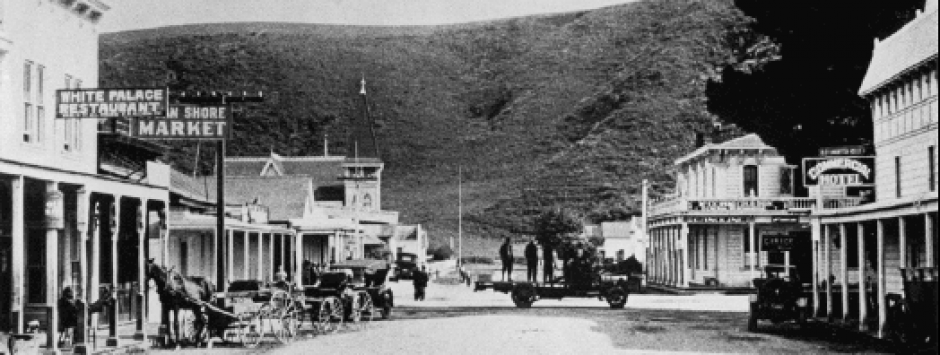
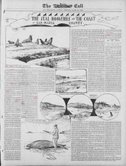

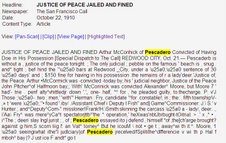
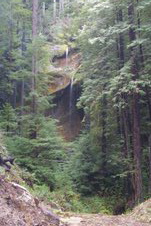
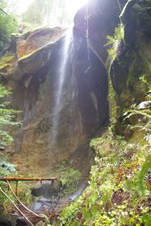
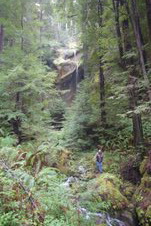

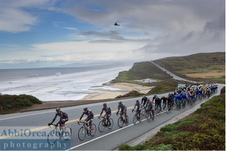



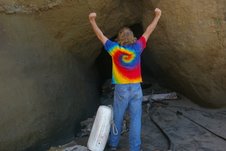 Story by John Vonderlin
Story by John Vonderlin